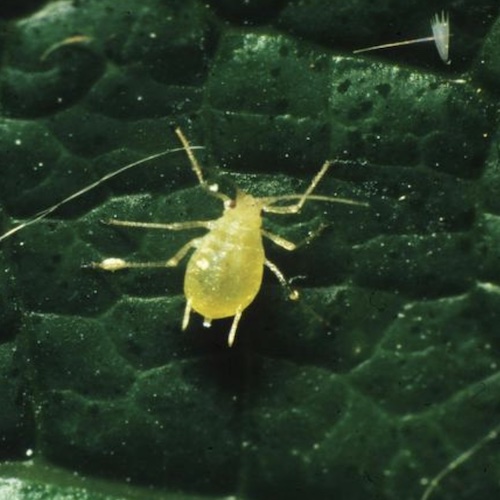
Knowledge Hub
Myzus persicae (Aphids)
Prevention and Control
Prevention
- M. persicaeare small green aphids which feed on plant sap. These aphids can transmit plant viruses
- Use of repellant plants such as onion, garlic and marigold in alternate rows to crop
- Use of agro nets (size 400 µm) to prevent pest accessing crop seedlings, and remove at flowering stage
- Conserve natural enemies (e.g. ladybird beetles, hoverflies and parasitoid wasps) by avoiding use of broad spectrum insecticides and providing suitable habitat
- Avoid high levels of nitrogen in soil, as this causes plants to become succulent and attractive to aphids
- Remove and burn crop residues immediately after harvest
Monitoring
- Start monitoring from seedling stage, look at lower leaves, stems or growing points for soft bodies insects, found in clusters
- Check underside of leaves, shoots and stems for immobile aphids
- Look for yellowing leaves, stunted growth and honeydew on infested crops. Sooty mould may grown on the honeydew
- Look for curled, wrinkled or cupped leaves and mosaic patterns on the leaves (alternating dark and light patches) - these are symptoms of viruses that can be transmitted by the aphid
- Monitor at least 3 times a week for aphids early in the morning/late in day during dry periods
- Start control measures when there is 10-20% infestation (i.e. 1-2 infested plants/10-20 plants in plots)
Direct Control
- Remove and burn infested plants to help reduce population spread
- Use yellow traps (at 2 traps per 30 m2 to attract and kill aphids
- Spray soap solution (potassium soaps e.g. Alata samina). Add 10-15 tablespoons of liquid soal in 16 L knapsack and spray foliage
- Spray with neem-based products and follow label instructions (e.g. Azatrol, 1.2% Azadiractin. 1 part Azatrol with 1 part water, spray at 7-10 day intervals)
Search
Activities
Downloads
© 2024 Safer Spice. All rights reserved.

 BACKGROUND
BACKGROUND




